BAP41 - ABC Learning Centres: Financial Statements Warning Analysis
VerifiedAdded on 2023/06/03
|30
|4947
|117
Essay
AI Summary
This essay provides a comprehensive analysis of the financial statements of ABC Learning Centres, aiming to determine if sufficient warning signals were present prior to its collapse. It applies DuPont analysis, common size trend analysis, and Beneish M-Score to evaluate the company's financial health from 2000 to 2007. The analysis reveals a continuous decline in key financial indicators such as return on equity, return on assets, and asset turnover ratios, despite reported revenue growth. The Beneish M-Score also indicates a weakening financial position over the years. The essay concludes that the deteriorating financial health was evident in the financial statements, suggesting that investors and lenders overlooked critical warning signs. The study recommends improved scrutiny of financial statements and the use of analytical tools for early detection of financial distress. Desklib offers a platform for students to access similar solved assignments and study resources.
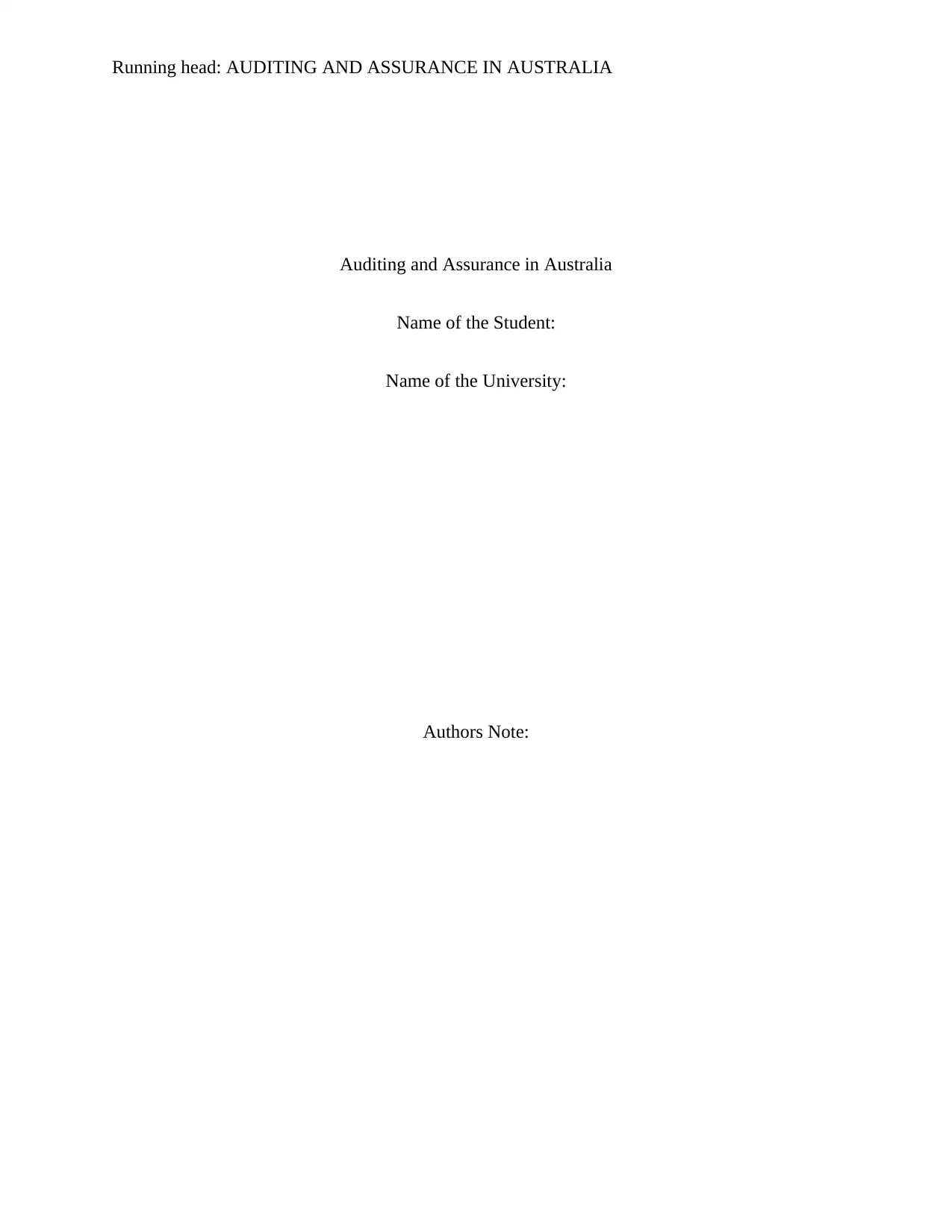
Running head: AUDITING AND ASSURANCE IN AUSTRALIA
Auditing and Assurance in Australia
Name of the Student:
Name of the University:
Authors Note:
Auditing and Assurance in Australia
Name of the Student:
Name of the University:
Authors Note:
Paraphrase This Document
Need a fresh take? Get an instant paraphrase of this document with our AI Paraphraser
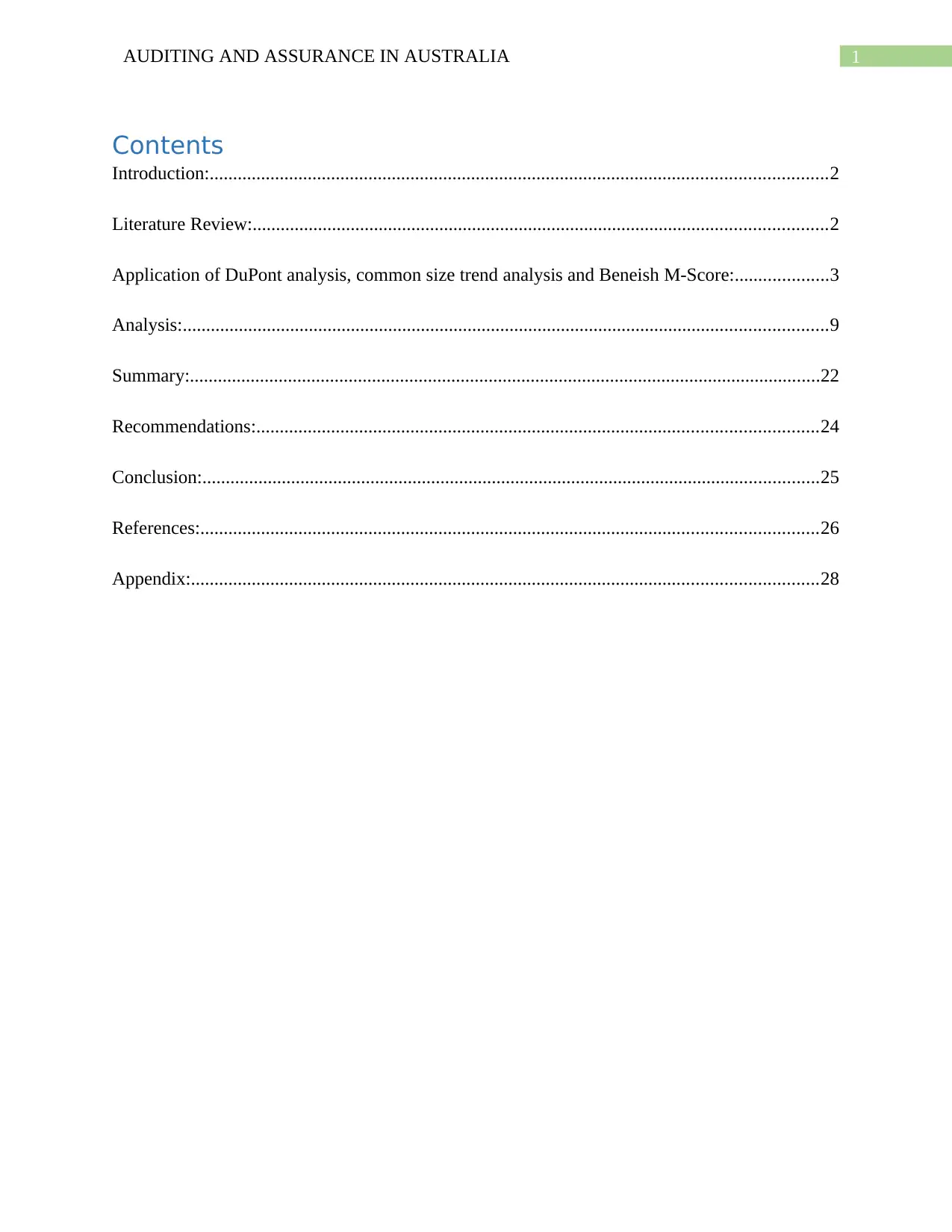
1AUDITING AND ASSURANCE IN AUSTRALIA
Contents
Introduction:....................................................................................................................................2
Literature Review:...........................................................................................................................2
Application of DuPont analysis, common size trend analysis and Beneish M-Score:....................3
Analysis:..........................................................................................................................................9
Summary:.......................................................................................................................................22
Recommendations:........................................................................................................................24
Conclusion:....................................................................................................................................25
References:....................................................................................................................................26
Appendix:......................................................................................................................................28
Contents
Introduction:....................................................................................................................................2
Literature Review:...........................................................................................................................2
Application of DuPont analysis, common size trend analysis and Beneish M-Score:....................3
Analysis:..........................................................................................................................................9
Summary:.......................................................................................................................................22
Recommendations:........................................................................................................................24
Conclusion:....................................................................................................................................25
References:....................................................................................................................................26
Appendix:......................................................................................................................................28
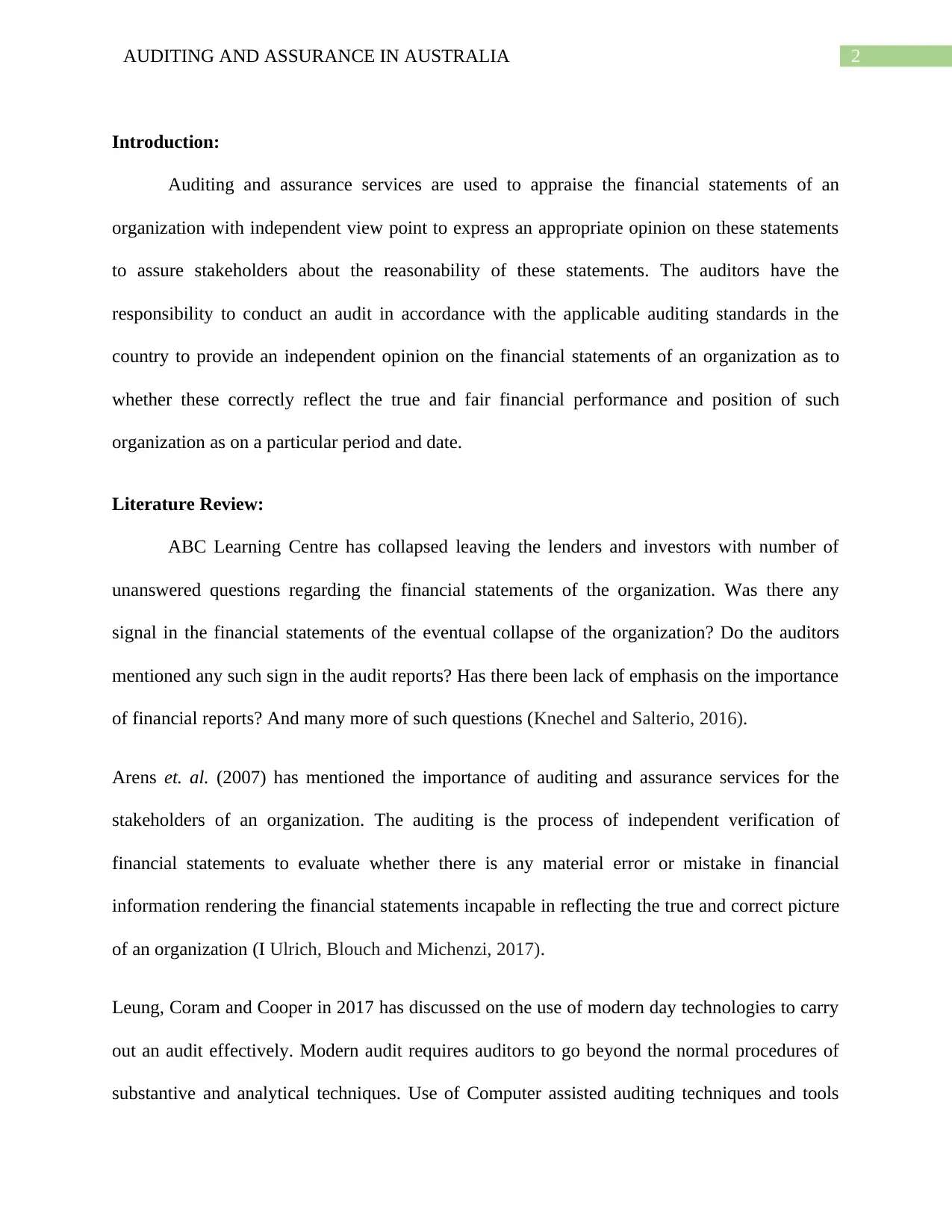
2AUDITING AND ASSURANCE IN AUSTRALIA
Introduction:
Auditing and assurance services are used to appraise the financial statements of an
organization with independent view point to express an appropriate opinion on these statements
to assure stakeholders about the reasonability of these statements. The auditors have the
responsibility to conduct an audit in accordance with the applicable auditing standards in the
country to provide an independent opinion on the financial statements of an organization as to
whether these correctly reflect the true and fair financial performance and position of such
organization as on a particular period and date.
Literature Review:
ABC Learning Centre has collapsed leaving the lenders and investors with number of
unanswered questions regarding the financial statements of the organization. Was there any
signal in the financial statements of the eventual collapse of the organization? Do the auditors
mentioned any such sign in the audit reports? Has there been lack of emphasis on the importance
of financial reports? And many more of such questions (Knechel and Salterio, 2016).
Arens et. al. (2007) has mentioned the importance of auditing and assurance services for the
stakeholders of an organization. The auditing is the process of independent verification of
financial statements to evaluate whether there is any material error or mistake in financial
information rendering the financial statements incapable in reflecting the true and correct picture
of an organization (I Ulrich, Blouch and Michenzi, 2017).
Leung, Coram and Cooper in 2017 has discussed on the use of modern day technologies to carry
out an audit effectively. Modern audit requires auditors to go beyond the normal procedures of
substantive and analytical techniques. Use of Computer assisted auditing techniques and tools
Introduction:
Auditing and assurance services are used to appraise the financial statements of an
organization with independent view point to express an appropriate opinion on these statements
to assure stakeholders about the reasonability of these statements. The auditors have the
responsibility to conduct an audit in accordance with the applicable auditing standards in the
country to provide an independent opinion on the financial statements of an organization as to
whether these correctly reflect the true and fair financial performance and position of such
organization as on a particular period and date.
Literature Review:
ABC Learning Centre has collapsed leaving the lenders and investors with number of
unanswered questions regarding the financial statements of the organization. Was there any
signal in the financial statements of the eventual collapse of the organization? Do the auditors
mentioned any such sign in the audit reports? Has there been lack of emphasis on the importance
of financial reports? And many more of such questions (Knechel and Salterio, 2016).
Arens et. al. (2007) has mentioned the importance of auditing and assurance services for the
stakeholders of an organization. The auditing is the process of independent verification of
financial statements to evaluate whether there is any material error or mistake in financial
information rendering the financial statements incapable in reflecting the true and correct picture
of an organization (I Ulrich, Blouch and Michenzi, 2017).
Leung, Coram and Cooper in 2017 has discussed on the use of modern day technologies to carry
out an audit effectively. Modern audit requires auditors to go beyond the normal procedures of
substantive and analytical techniques. Use of Computer assisted auditing techniques and tools
⊘ This is a preview!⊘
Do you want full access?
Subscribe today to unlock all pages.

Trusted by 1+ million students worldwide
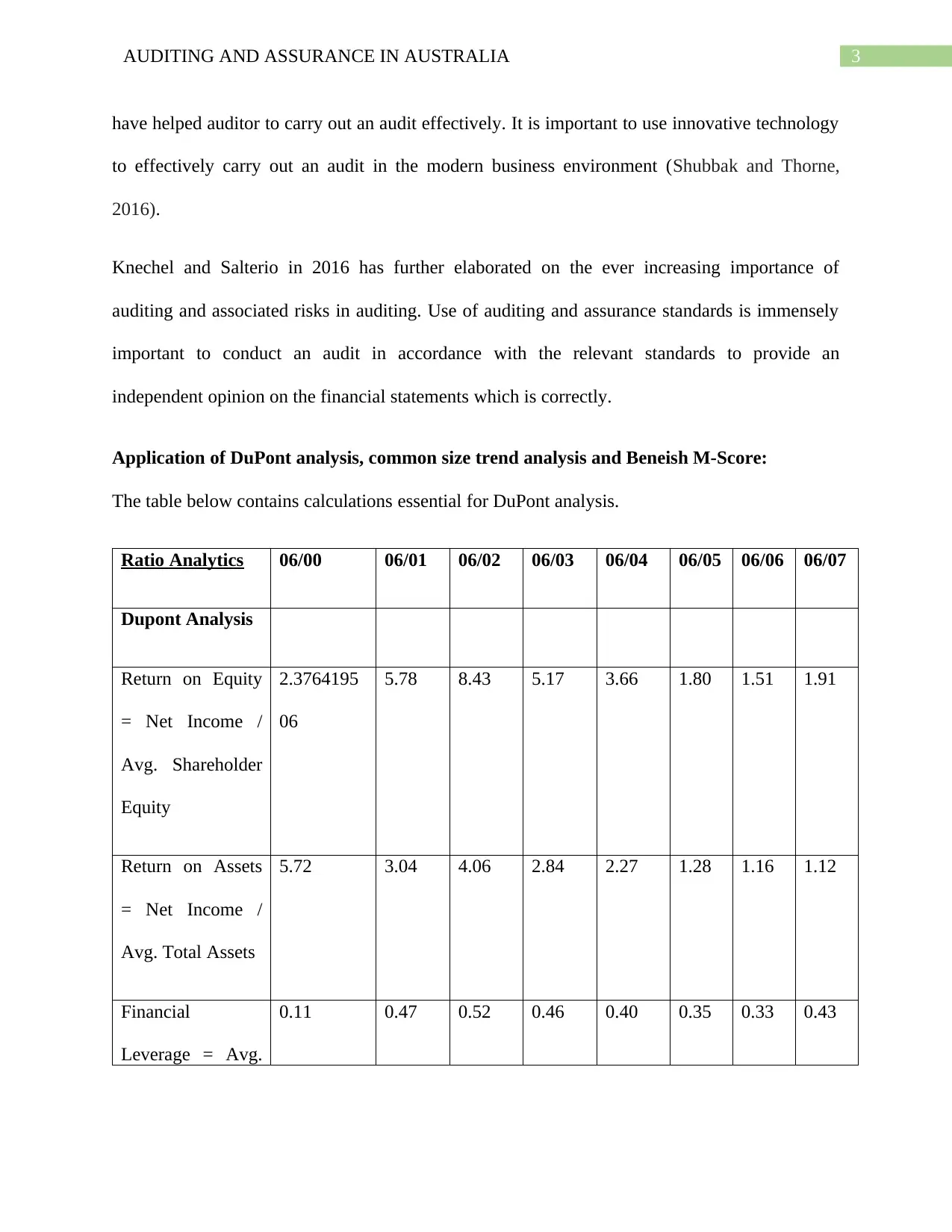
3AUDITING AND ASSURANCE IN AUSTRALIA
have helped auditor to carry out an audit effectively. It is important to use innovative technology
to effectively carry out an audit in the modern business environment (Shubbak and Thorne,
2016).
Knechel and Salterio in 2016 has further elaborated on the ever increasing importance of
auditing and associated risks in auditing. Use of auditing and assurance standards is immensely
important to conduct an audit in accordance with the relevant standards to provide an
independent opinion on the financial statements which is correctly.
Application of DuPont analysis, common size trend analysis and Beneish M-Score:
The table below contains calculations essential for DuPont analysis.
Ratio Analytics 06/00 06/01 06/02 06/03 06/04 06/05 06/06 06/07
Dupont Analysis
Return on Equity
= Net Income /
Avg. Shareholder
Equity
2.3764195
06
5.78 8.43 5.17 3.66 1.80 1.51 1.91
Return on Assets
= Net Income /
Avg. Total Assets
5.72 3.04 4.06 2.84 2.27 1.28 1.16 1.12
Financial
Leverage = Avg.
0.11 0.47 0.52 0.46 0.40 0.35 0.33 0.43
have helped auditor to carry out an audit effectively. It is important to use innovative technology
to effectively carry out an audit in the modern business environment (Shubbak and Thorne,
2016).
Knechel and Salterio in 2016 has further elaborated on the ever increasing importance of
auditing and associated risks in auditing. Use of auditing and assurance standards is immensely
important to conduct an audit in accordance with the relevant standards to provide an
independent opinion on the financial statements which is correctly.
Application of DuPont analysis, common size trend analysis and Beneish M-Score:
The table below contains calculations essential for DuPont analysis.
Ratio Analytics 06/00 06/01 06/02 06/03 06/04 06/05 06/06 06/07
Dupont Analysis
Return on Equity
= Net Income /
Avg. Shareholder
Equity
2.3764195
06
5.78 8.43 5.17 3.66 1.80 1.51 1.91
Return on Assets
= Net Income /
Avg. Total Assets
5.72 3.04 4.06 2.84 2.27 1.28 1.16 1.12
Financial
Leverage = Avg.
0.11 0.47 0.52 0.46 0.40 0.35 0.33 0.43
Paraphrase This Document
Need a fresh take? Get an instant paraphrase of this document with our AI Paraphraser
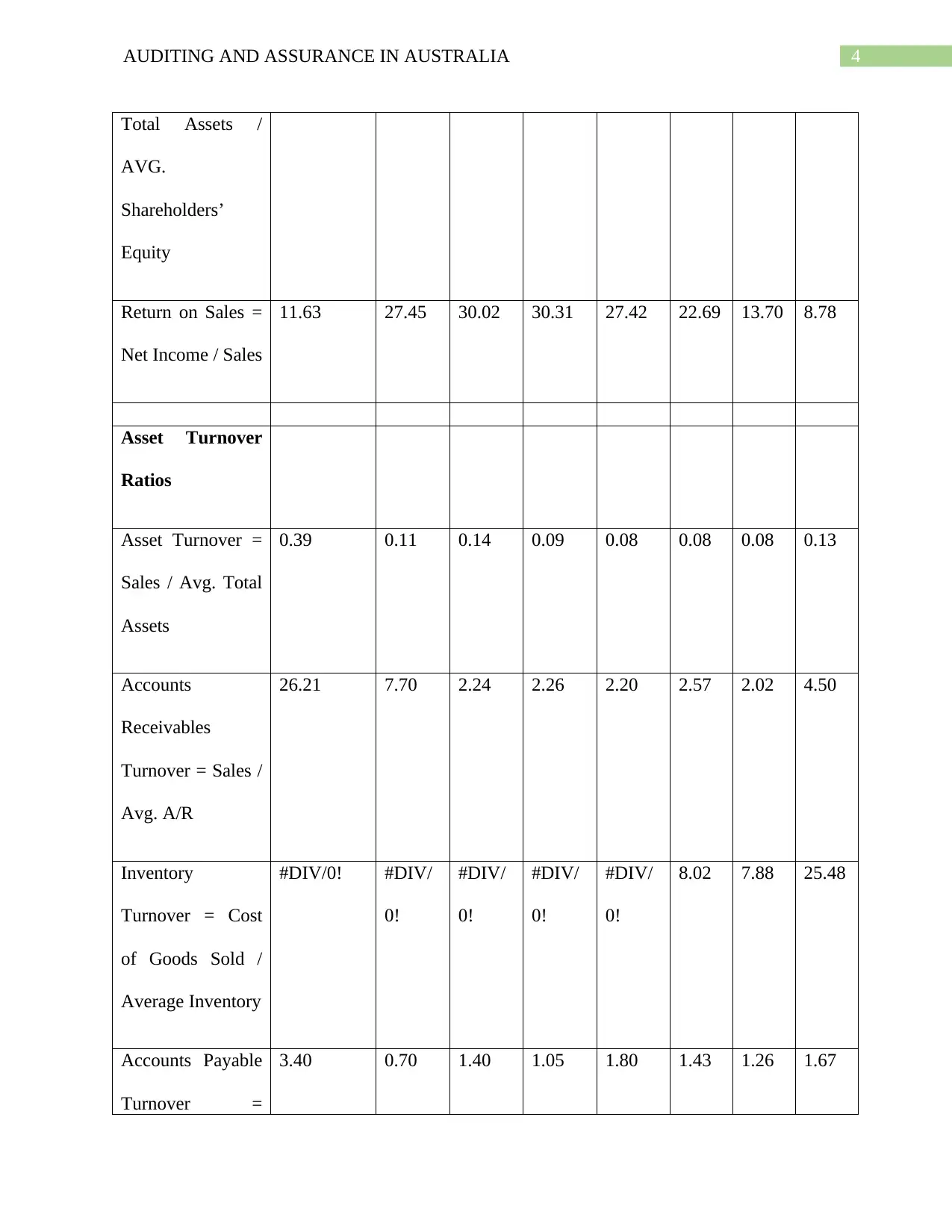
4AUDITING AND ASSURANCE IN AUSTRALIA
Total Assets /
AVG.
Shareholders’
Equity
Return on Sales =
Net Income / Sales
11.63 27.45 30.02 30.31 27.42 22.69 13.70 8.78
Asset Turnover
Ratios
Asset Turnover =
Sales / Avg. Total
Assets
0.39 0.11 0.14 0.09 0.08 0.08 0.08 0.13
Accounts
Receivables
Turnover = Sales /
Avg. A/R
26.21 7.70 2.24 2.26 2.20 2.57 2.02 4.50
Inventory
Turnover = Cost
of Goods Sold /
Average Inventory
#DIV/0! #DIV/
0!
#DIV/
0!
#DIV/
0!
#DIV/
0!
8.02 7.88 25.48
Accounts Payable
Turnover =
3.40 0.70 1.40 1.05 1.80 1.43 1.26 1.67
Total Assets /
AVG.
Shareholders’
Equity
Return on Sales =
Net Income / Sales
11.63 27.45 30.02 30.31 27.42 22.69 13.70 8.78
Asset Turnover
Ratios
Asset Turnover =
Sales / Avg. Total
Assets
0.39 0.11 0.14 0.09 0.08 0.08 0.08 0.13
Accounts
Receivables
Turnover = Sales /
Avg. A/R
26.21 7.70 2.24 2.26 2.20 2.57 2.02 4.50
Inventory
Turnover = Cost
of Goods Sold /
Average Inventory
#DIV/0! #DIV/
0!
#DIV/
0!
#DIV/
0!
#DIV/
0!
8.02 7.88 25.48
Accounts Payable
Turnover =
3.40 0.70 1.40 1.05 1.80 1.43 1.26 1.67
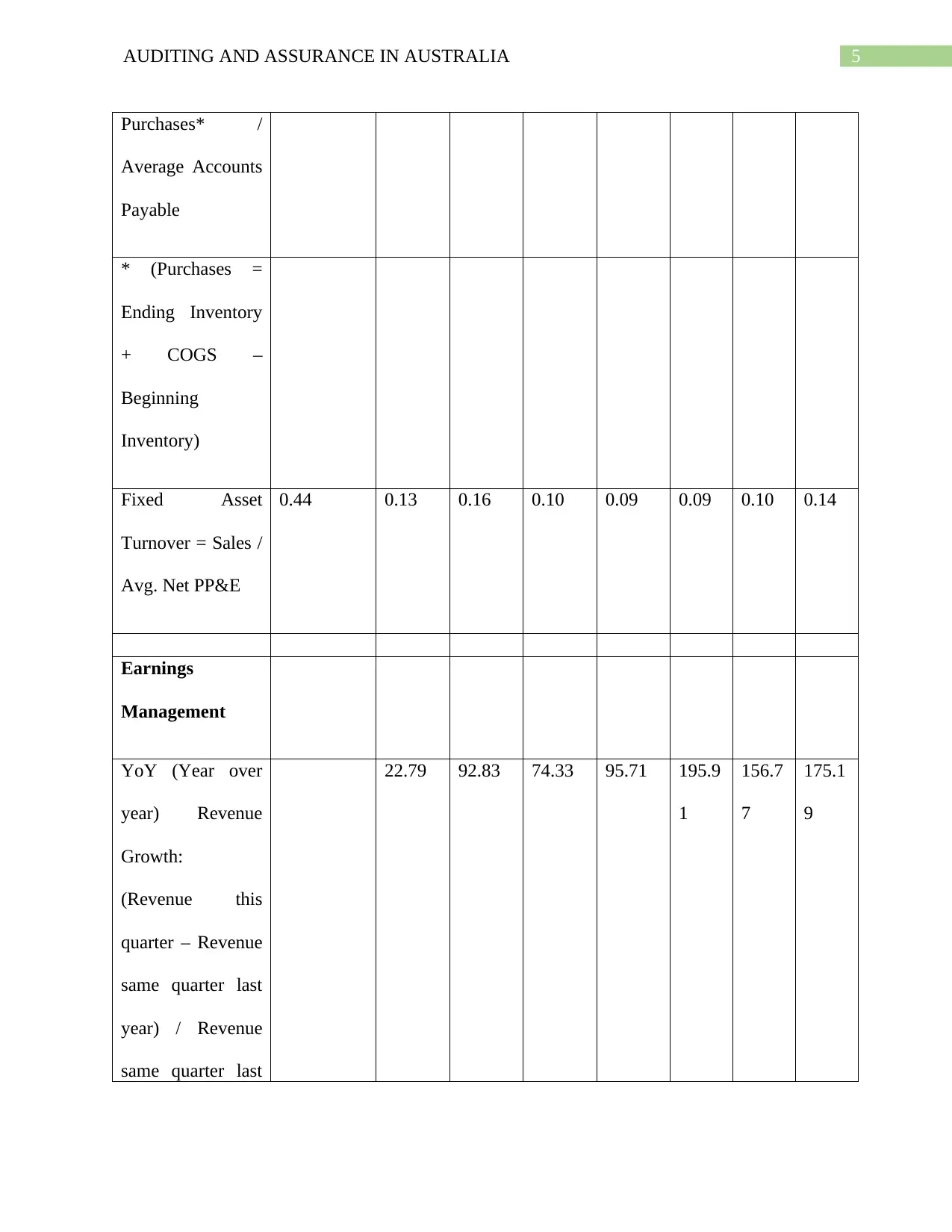
5AUDITING AND ASSURANCE IN AUSTRALIA
Purchases* /
Average Accounts
Payable
* (Purchases =
Ending Inventory
+ COGS –
Beginning
Inventory)
Fixed Asset
Turnover = Sales /
Avg. Net PP&E
0.44 0.13 0.16 0.10 0.09 0.09 0.10 0.14
Earnings
Management
YoY (Year over
year) Revenue
Growth:
(Revenue this
quarter – Revenue
same quarter last
year) / Revenue
same quarter last
22.79 92.83 74.33 95.71 195.9
1
156.7
7
175.1
9
Purchases* /
Average Accounts
Payable
* (Purchases =
Ending Inventory
+ COGS –
Beginning
Inventory)
Fixed Asset
Turnover = Sales /
Avg. Net PP&E
0.44 0.13 0.16 0.10 0.09 0.09 0.10 0.14
Earnings
Management
YoY (Year over
year) Revenue
Growth:
(Revenue this
quarter – Revenue
same quarter last
year) / Revenue
same quarter last
22.79 92.83 74.33 95.71 195.9
1
156.7
7
175.1
9
⊘ This is a preview!⊘
Do you want full access?
Subscribe today to unlock all pages.

Trusted by 1+ million students worldwide
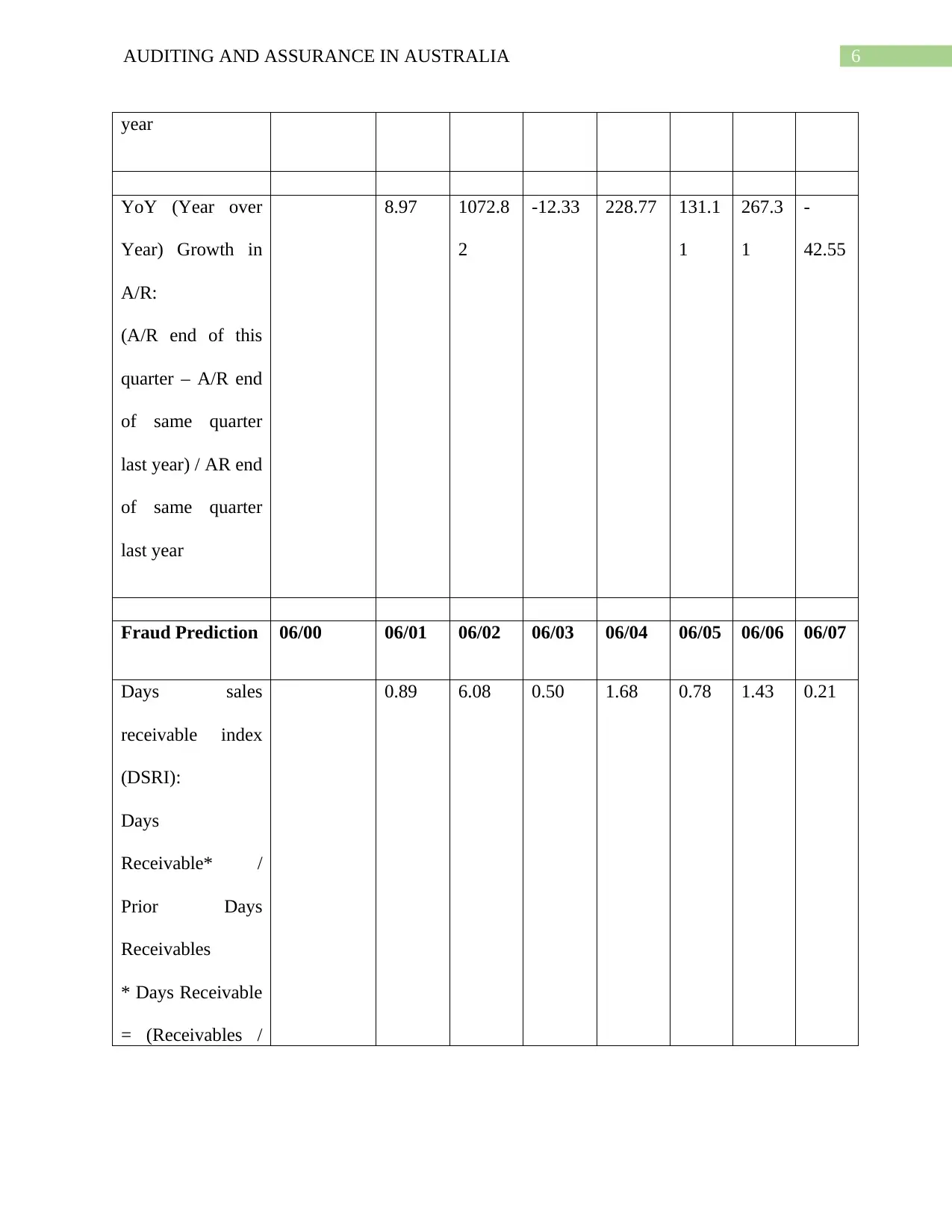
6AUDITING AND ASSURANCE IN AUSTRALIA
year
YoY (Year over
Year) Growth in
A/R:
(A/R end of this
quarter – A/R end
of same quarter
last year) / AR end
of same quarter
last year
8.97 1072.8
2
-12.33 228.77 131.1
1
267.3
1
-
42.55
Fraud Prediction 06/00 06/01 06/02 06/03 06/04 06/05 06/06 06/07
Days sales
receivable index
(DSRI):
Days
Receivable* /
Prior Days
Receivables
* Days Receivable
= (Receivables /
0.89 6.08 0.50 1.68 0.78 1.43 0.21
year
YoY (Year over
Year) Growth in
A/R:
(A/R end of this
quarter – A/R end
of same quarter
last year) / AR end
of same quarter
last year
8.97 1072.8
2
-12.33 228.77 131.1
1
267.3
1
-
42.55
Fraud Prediction 06/00 06/01 06/02 06/03 06/04 06/05 06/06 06/07
Days sales
receivable index
(DSRI):
Days
Receivable* /
Prior Days
Receivables
* Days Receivable
= (Receivables /
0.89 6.08 0.50 1.68 0.78 1.43 0.21
Paraphrase This Document
Need a fresh take? Get an instant paraphrase of this document with our AI Paraphraser
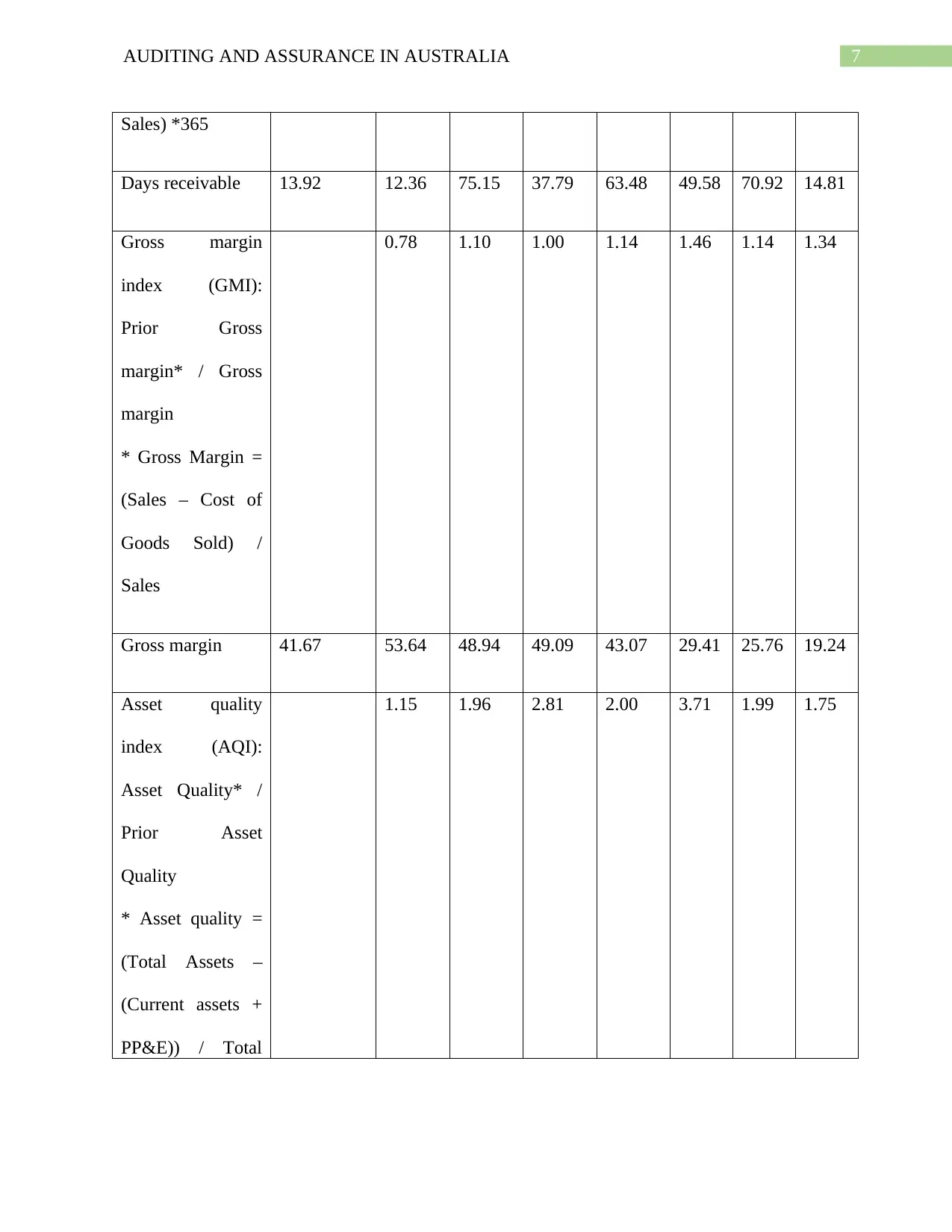
7AUDITING AND ASSURANCE IN AUSTRALIA
Sales) *365
Days receivable 13.92 12.36 75.15 37.79 63.48 49.58 70.92 14.81
Gross margin
index (GMI):
Prior Gross
margin* / Gross
margin
* Gross Margin =
(Sales – Cost of
Goods Sold) /
Sales
0.78 1.10 1.00 1.14 1.46 1.14 1.34
Gross margin 41.67 53.64 48.94 49.09 43.07 29.41 25.76 19.24
Asset quality
index (AQI):
Asset Quality* /
Prior Asset
Quality
* Asset quality =
(Total Assets –
(Current assets +
PP&E)) / Total
1.15 1.96 2.81 2.00 3.71 1.99 1.75
Sales) *365
Days receivable 13.92 12.36 75.15 37.79 63.48 49.58 70.92 14.81
Gross margin
index (GMI):
Prior Gross
margin* / Gross
margin
* Gross Margin =
(Sales – Cost of
Goods Sold) /
Sales
0.78 1.10 1.00 1.14 1.46 1.14 1.34
Gross margin 41.67 53.64 48.94 49.09 43.07 29.41 25.76 19.24
Asset quality
index (AQI):
Asset Quality* /
Prior Asset
Quality
* Asset quality =
(Total Assets –
(Current assets +
PP&E)) / Total
1.15 1.96 2.81 2.00 3.71 1.99 1.75
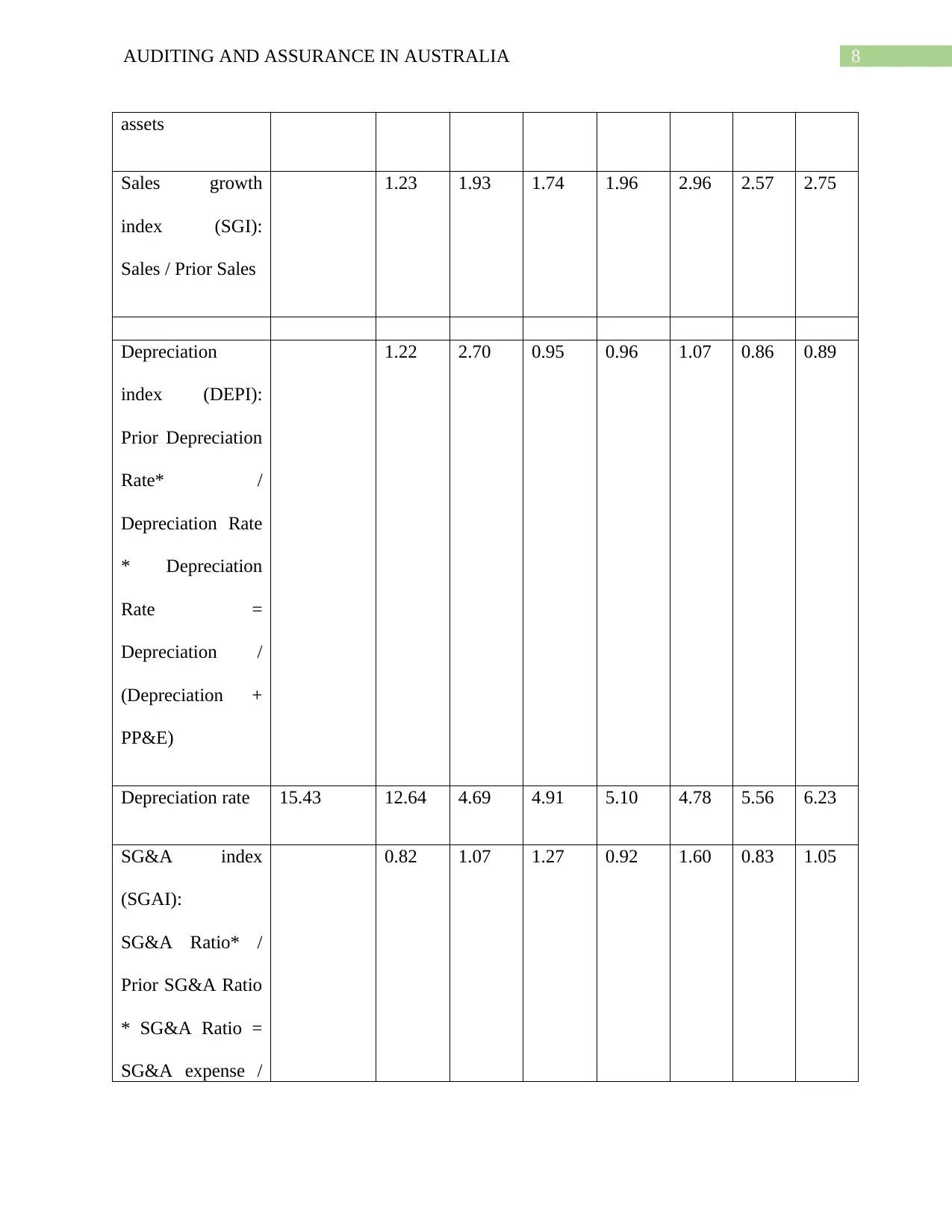
8AUDITING AND ASSURANCE IN AUSTRALIA
assets
Sales growth
index (SGI):
Sales / Prior Sales
1.23 1.93 1.74 1.96 2.96 2.57 2.75
Depreciation
index (DEPI):
Prior Depreciation
Rate* /
Depreciation Rate
* Depreciation
Rate =
Depreciation /
(Depreciation +
PP&E)
1.22 2.70 0.95 0.96 1.07 0.86 0.89
Depreciation rate 15.43 12.64 4.69 4.91 5.10 4.78 5.56 6.23
SG&A index
(SGAI):
SG&A Ratio* /
Prior SG&A Ratio
* SG&A Ratio =
SG&A expense /
0.82 1.07 1.27 0.92 1.60 0.83 1.05
assets
Sales growth
index (SGI):
Sales / Prior Sales
1.23 1.93 1.74 1.96 2.96 2.57 2.75
Depreciation
index (DEPI):
Prior Depreciation
Rate* /
Depreciation Rate
* Depreciation
Rate =
Depreciation /
(Depreciation +
PP&E)
1.22 2.70 0.95 0.96 1.07 0.86 0.89
Depreciation rate 15.43 12.64 4.69 4.91 5.10 4.78 5.56 6.23
SG&A index
(SGAI):
SG&A Ratio* /
Prior SG&A Ratio
* SG&A Ratio =
SG&A expense /
0.82 1.07 1.27 0.92 1.60 0.83 1.05
⊘ This is a preview!⊘
Do you want full access?
Subscribe today to unlock all pages.

Trusted by 1+ million students worldwide
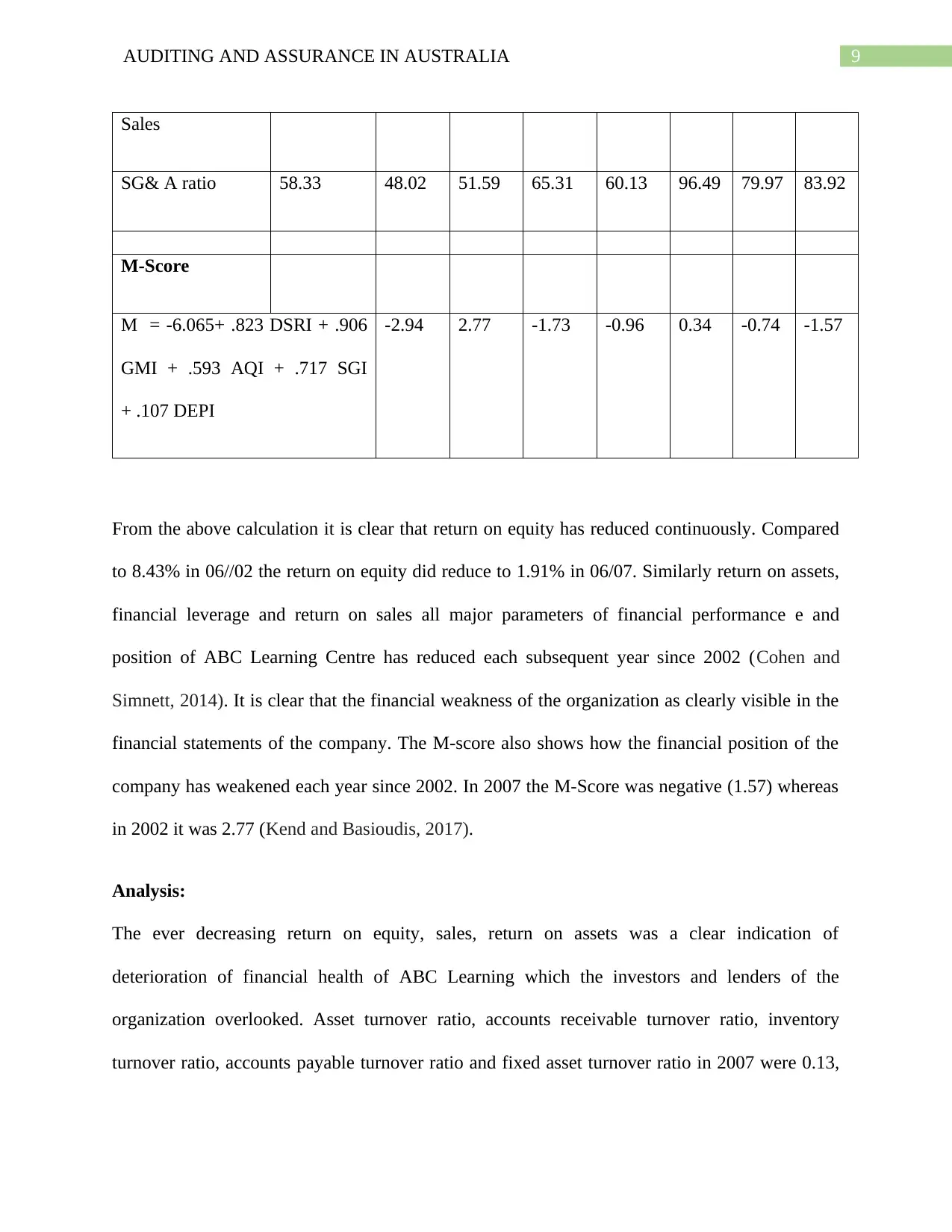
9AUDITING AND ASSURANCE IN AUSTRALIA
Sales
SG& A ratio 58.33 48.02 51.59 65.31 60.13 96.49 79.97 83.92
M-Score
M = -6.065+ .823 DSRI + .906
GMI + .593 AQI + .717 SGI
+ .107 DEPI
-2.94 2.77 -1.73 -0.96 0.34 -0.74 -1.57
From the above calculation it is clear that return on equity has reduced continuously. Compared
to 8.43% in 06//02 the return on equity did reduce to 1.91% in 06/07. Similarly return on assets,
financial leverage and return on sales all major parameters of financial performance e and
position of ABC Learning Centre has reduced each subsequent year since 2002 (Cohen and
Simnett, 2014). It is clear that the financial weakness of the organization as clearly visible in the
financial statements of the company. The M-score also shows how the financial position of the
company has weakened each year since 2002. In 2007 the M-Score was negative (1.57) whereas
in 2002 it was 2.77 (Kend and Basioudis, 2017).
Analysis:
The ever decreasing return on equity, sales, return on assets was a clear indication of
deterioration of financial health of ABC Learning which the investors and lenders of the
organization overlooked. Asset turnover ratio, accounts receivable turnover ratio, inventory
turnover ratio, accounts payable turnover ratio and fixed asset turnover ratio in 2007 were 0.13,
Sales
SG& A ratio 58.33 48.02 51.59 65.31 60.13 96.49 79.97 83.92
M-Score
M = -6.065+ .823 DSRI + .906
GMI + .593 AQI + .717 SGI
+ .107 DEPI
-2.94 2.77 -1.73 -0.96 0.34 -0.74 -1.57
From the above calculation it is clear that return on equity has reduced continuously. Compared
to 8.43% in 06//02 the return on equity did reduce to 1.91% in 06/07. Similarly return on assets,
financial leverage and return on sales all major parameters of financial performance e and
position of ABC Learning Centre has reduced each subsequent year since 2002 (Cohen and
Simnett, 2014). It is clear that the financial weakness of the organization as clearly visible in the
financial statements of the company. The M-score also shows how the financial position of the
company has weakened each year since 2002. In 2007 the M-Score was negative (1.57) whereas
in 2002 it was 2.77 (Kend and Basioudis, 2017).
Analysis:
The ever decreasing return on equity, sales, return on assets was a clear indication of
deterioration of financial health of ABC Learning which the investors and lenders of the
organization overlooked. Asset turnover ratio, accounts receivable turnover ratio, inventory
turnover ratio, accounts payable turnover ratio and fixed asset turnover ratio in 2007 were 0.13,
Paraphrase This Document
Need a fresh take? Get an instant paraphrase of this document with our AI Paraphraser
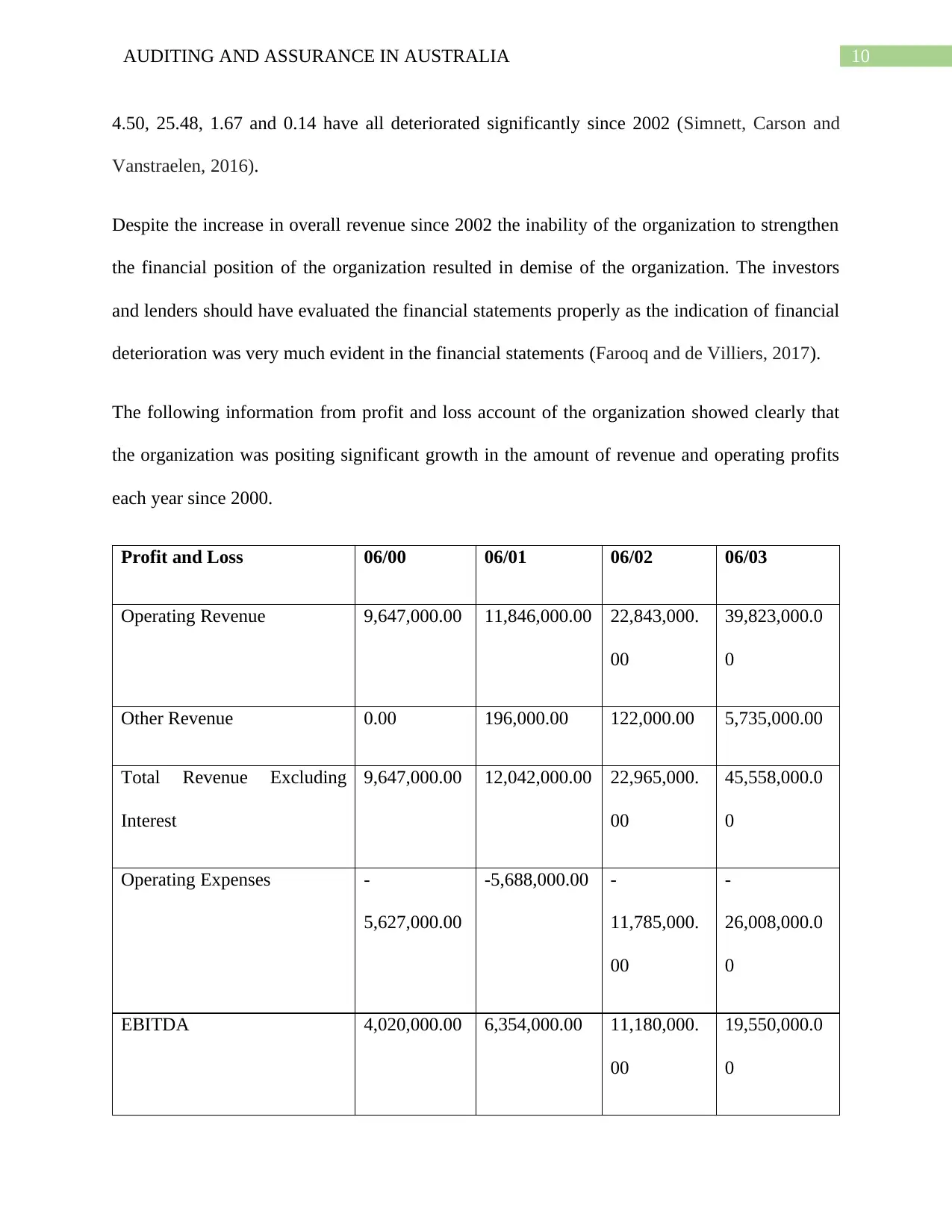
10AUDITING AND ASSURANCE IN AUSTRALIA
4.50, 25.48, 1.67 and 0.14 have all deteriorated significantly since 2002 (Simnett, Carson and
Vanstraelen, 2016).
Despite the increase in overall revenue since 2002 the inability of the organization to strengthen
the financial position of the organization resulted in demise of the organization. The investors
and lenders should have evaluated the financial statements properly as the indication of financial
deterioration was very much evident in the financial statements (Farooq and de Villiers, 2017).
The following information from profit and loss account of the organization showed clearly that
the organization was positing significant growth in the amount of revenue and operating profits
each year since 2000.
Profit and Loss 06/00 06/01 06/02 06/03
Operating Revenue 9,647,000.00 11,846,000.00 22,843,000.
00
39,823,000.0
0
Other Revenue 0.00 196,000.00 122,000.00 5,735,000.00
Total Revenue Excluding
Interest
9,647,000.00 12,042,000.00 22,965,000.
00
45,558,000.0
0
Operating Expenses -
5,627,000.00
-5,688,000.00 -
11,785,000.
00
-
26,008,000.0
0
EBITDA 4,020,000.00 6,354,000.00 11,180,000.
00
19,550,000.0
0
4.50, 25.48, 1.67 and 0.14 have all deteriorated significantly since 2002 (Simnett, Carson and
Vanstraelen, 2016).
Despite the increase in overall revenue since 2002 the inability of the organization to strengthen
the financial position of the organization resulted in demise of the organization. The investors
and lenders should have evaluated the financial statements properly as the indication of financial
deterioration was very much evident in the financial statements (Farooq and de Villiers, 2017).
The following information from profit and loss account of the organization showed clearly that
the organization was positing significant growth in the amount of revenue and operating profits
each year since 2000.
Profit and Loss 06/00 06/01 06/02 06/03
Operating Revenue 9,647,000.00 11,846,000.00 22,843,000.
00
39,823,000.0
0
Other Revenue 0.00 196,000.00 122,000.00 5,735,000.00
Total Revenue Excluding
Interest
9,647,000.00 12,042,000.00 22,965,000.
00
45,558,000.0
0
Operating Expenses -
5,627,000.00
-5,688,000.00 -
11,785,000.
00
-
26,008,000.0
0
EBITDA 4,020,000.00 6,354,000.00 11,180,000.
00
19,550,000.0
0
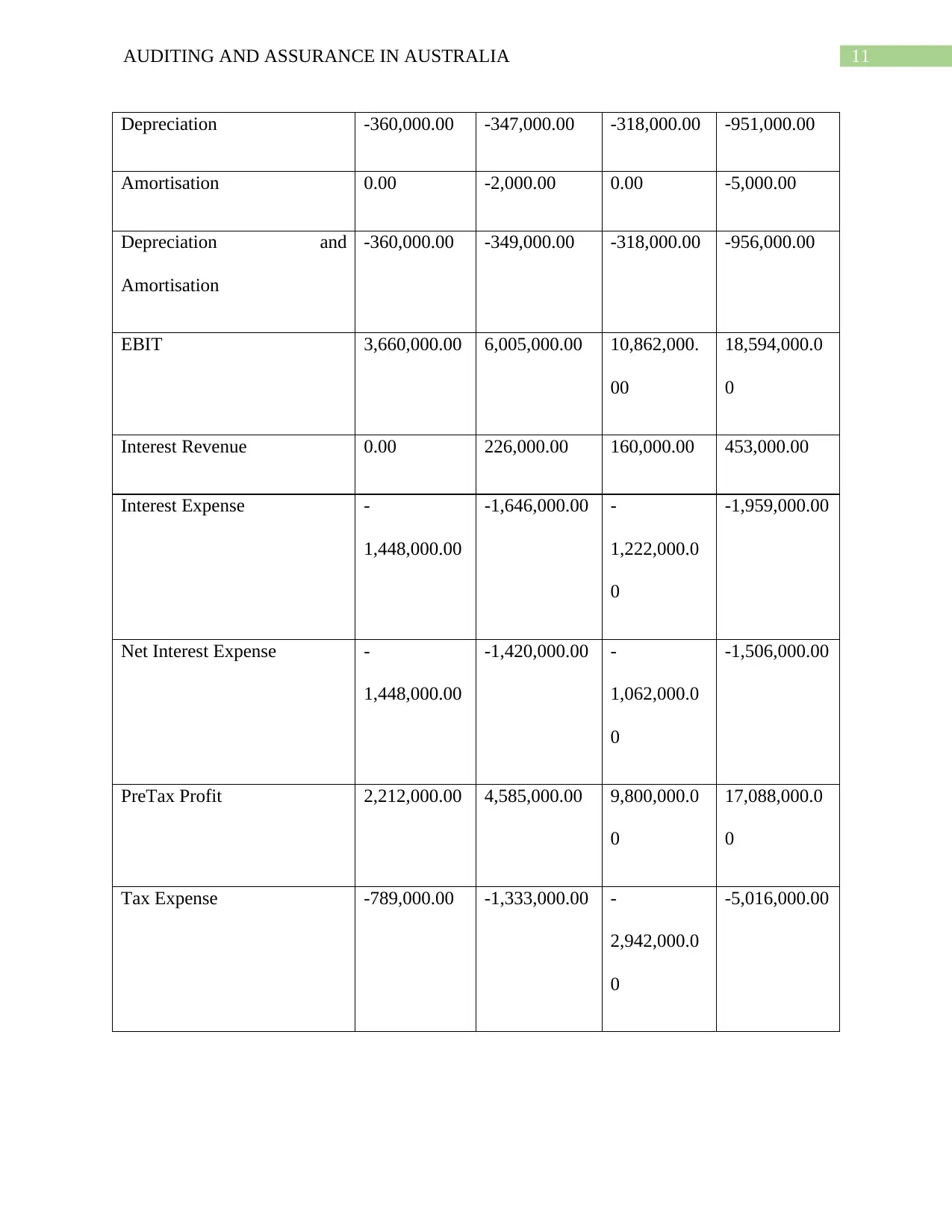
11AUDITING AND ASSURANCE IN AUSTRALIA
Depreciation -360,000.00 -347,000.00 -318,000.00 -951,000.00
Amortisation 0.00 -2,000.00 0.00 -5,000.00
Depreciation and
Amortisation
-360,000.00 -349,000.00 -318,000.00 -956,000.00
EBIT 3,660,000.00 6,005,000.00 10,862,000.
00
18,594,000.0
0
Interest Revenue 0.00 226,000.00 160,000.00 453,000.00
Interest Expense -
1,448,000.00
-1,646,000.00 -
1,222,000.0
0
-1,959,000.00
Net Interest Expense -
1,448,000.00
-1,420,000.00 -
1,062,000.0
0
-1,506,000.00
PreTax Profit 2,212,000.00 4,585,000.00 9,800,000.0
0
17,088,000.0
0
Tax Expense -789,000.00 -1,333,000.00 -
2,942,000.0
0
-5,016,000.00
Depreciation -360,000.00 -347,000.00 -318,000.00 -951,000.00
Amortisation 0.00 -2,000.00 0.00 -5,000.00
Depreciation and
Amortisation
-360,000.00 -349,000.00 -318,000.00 -956,000.00
EBIT 3,660,000.00 6,005,000.00 10,862,000.
00
18,594,000.0
0
Interest Revenue 0.00 226,000.00 160,000.00 453,000.00
Interest Expense -
1,448,000.00
-1,646,000.00 -
1,222,000.0
0
-1,959,000.00
Net Interest Expense -
1,448,000.00
-1,420,000.00 -
1,062,000.0
0
-1,506,000.00
PreTax Profit 2,212,000.00 4,585,000.00 9,800,000.0
0
17,088,000.0
0
Tax Expense -789,000.00 -1,333,000.00 -
2,942,000.0
0
-5,016,000.00
⊘ This is a preview!⊘
Do you want full access?
Subscribe today to unlock all pages.

Trusted by 1+ million students worldwide
1 out of 30
Related Documents
Your All-in-One AI-Powered Toolkit for Academic Success.
+13062052269
info@desklib.com
Available 24*7 on WhatsApp / Email
![[object Object]](/_next/static/media/star-bottom.7253800d.svg)
Unlock your academic potential
Copyright © 2020–2025 A2Z Services. All Rights Reserved. Developed and managed by ZUCOL.





